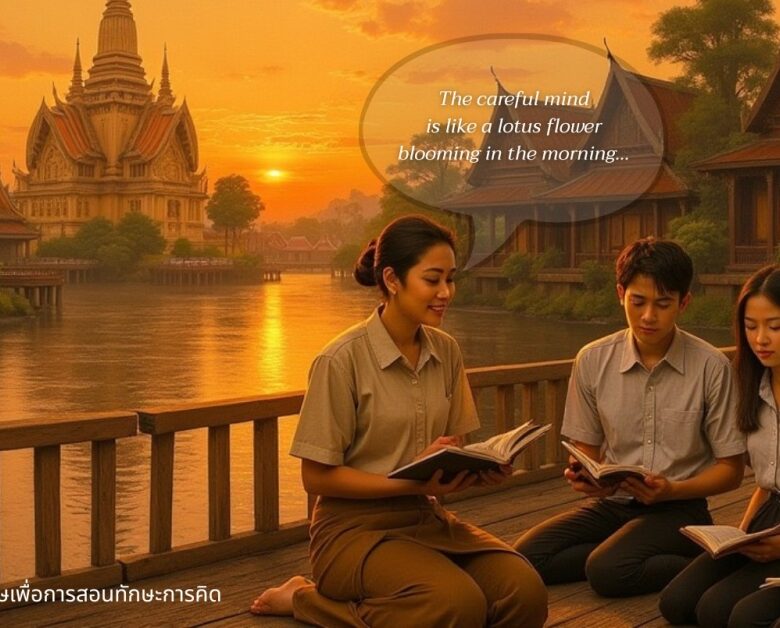"While much Buddhist poetry comes from ordained monks, Ajarn David’s perspective as a layperson and expatriate in Thailand brings a refreshing dimension to the genre."
Modern Buddhist Poetry
A
jarn David’s Poems from Sakon Nakhon is a simple yet elegant entry in the tradition of Buddhist poetry, offering a contemporary perspective deeply rooted in the philosophy and practices of Theravāda Buddhism in Thailand. Written in both English and Thai, the collection bridges cultures while capturing universal truths that resonate with readers from any background.
Historical Context
F
or centuries, poetry has been a medium through which Buddhist teachings are conveyed. From the Theragāthā and Therīgāthā — collections of early Buddhist verses composed by monks and nuns — to Japanese haiku and Chinese Zen poetry, Buddhist poetry has sought to distill complex teachings into simple, evocative images and metaphors.
Ajarn David’s work aligns with this tradition, yet it stands apart by bringing these teachings into the context of rural (Isaan) Thailand, a region steeped in the rhythms of Buddhist practice. His poems, like those of ancient Buddhist poets, explore themes of impermanence, suffering, and mindfulness while remaining grounded in the everyday experiences of life.
Buddhist Philosophy Made Tangible
A
jarn David’s Thai poetry excels in illustrating Buddhist concepts through accessible and relatable imagery. A recurring theme in the collection is anicca (impermanence). In one poem, he reflects on the transient nature of life by observing how the rainy season transforms the landscape — a metaphor for the cycles of change and renewal that permeate existence.
Compassion, another cornerstone of Buddhist practice, is central to poems such as the one that deals with prostration. There, Ajarn David conveys the humility and gratitude inherent in Buddhist rituals, emphasizing that these acts are not about submission but acknowledgment of the sacrifices made by others.
An Expat Voice for Thai Buddhism
W hile much Buddhist poetry comes from ordained monks, Ajarn David’s perspective as a layperson and expatriate in Thailand brings a refreshing dimension to the genre. His reflections are infused with a deep respect for Thai Buddhist traditions, yet they remain relatable to those unfamiliar with them.
For instance, his Thai poem about a hermit monk suggests that the longing for solitude and self-discovery is universal, transcending cultural and religious boundaries. This modern framing of Buddhist themes ensures the poems resonate with readers navigating the complexities of contemporary life.
The Poetic Style of Mindfulness
M
indfulness is not just a subject in Poems from Sakon Nakhon; it is woven into the fabric of the poetry itself. The deliberate pacing of the verses, the simplicity of the language, and the vivid imagery all reflect a mindful approach to writing. Each poem invites the reader to pause, reflect, and be present with the words— an experience akin to meditation.
For example, Ajarn David describes the act of bowing in Buddhist practice with elegant economy: it is “a lowering of the self in gratitude.” In this single line, he encapsulates both the action and its profound significance, encouraging readers to consider the value of humility in their own lives.
The Rural Thai Setting: A Catalyst for Reflection
U
nlike the mountainous monasteries or urban temples that often serve as backdrops in Buddhist poetry, the setting of Sakon Nakhon offers a unique lens. The Isaan Thai landscape, with its rice fields, monsoons, and temples nestled among villages, serves as both subject and metaphor throughout the collection.
This setting reinforces the Buddhist emphasis on interconnectedness — between humans and nature, tradition and modernity, the individual and the community. It also provides a grounded perspective that makes the spiritual teachings feel immediate and practical, rather than abstract.
A Buddhist Bridge Between Cultures
I
n presenting Buddhist teachings through a bilingual format, Poems from Sakon Nakhon opens a door for readers from diverse cultural and linguistic backgrounds. For English readers, the book provides a glimpse into the heart of Thai Buddhism, revealing how these teachings are lived in everyday life. For Thai readers, the English translations offer a fresh perspective on familiar traditions, making the teachings feel newly relevant.
This dual-language approach also places the book within a broader global context of Buddhist poetry, showing how the ancient wisdom of the Buddha continues to inspire new interpretations across languages and cultures.
A Spiritual Offering for All Readers
U
ltimately, Poems from Sakon Nakhon (Thai Poetry in English) is not just a book for Buddhists; it is a book for anyone seeking to deepen their understanding of themselves and the world around them. By exploring themes of impermanence, compassion, and mindfulness, Ajarn David offers readers a guide to navigating life’s challenges with greater clarity and peace.
For those interested in Buddhist poetry, this collection is a valuable addition to the canon. It brings the teachings of the Buddha into a modern, relatable context while honoring the timeless traditions of the genre. Whether you are a practitioner, a poetry lover, or simply curious about Buddhist philosophy, Poems from Sakon Nakhon is a journey worth taking.





